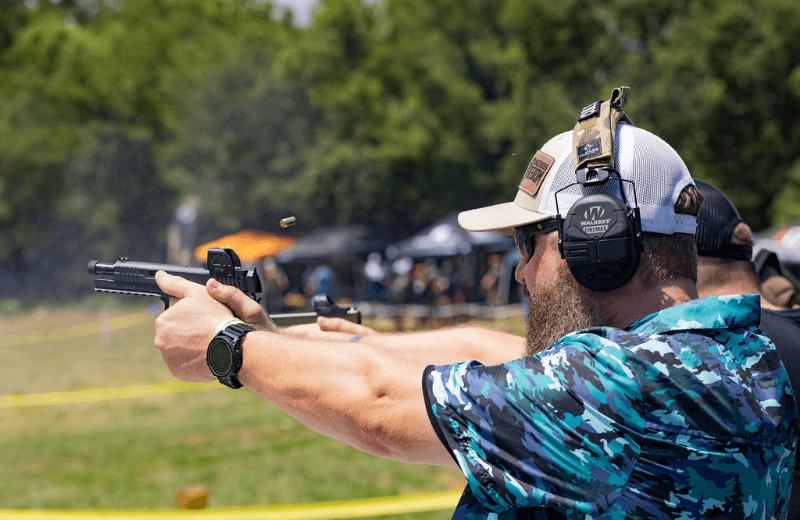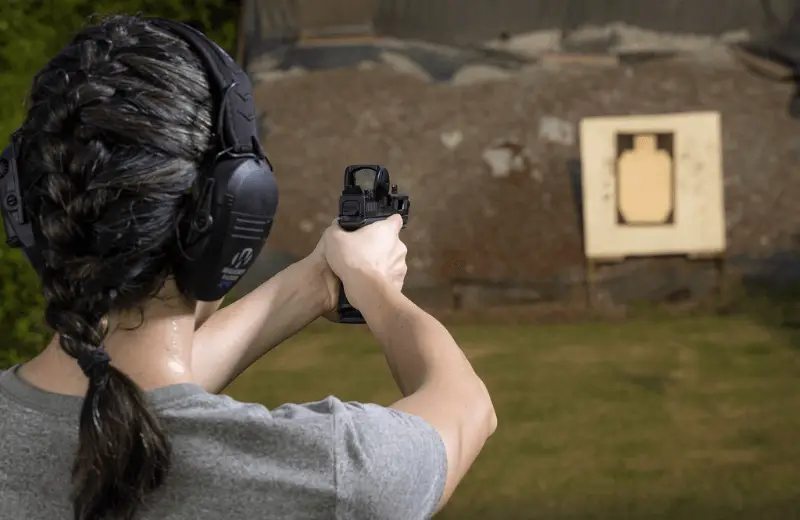No products in the cart.
One of the most often forgotten factors affecting accuracy, eye dominance and shooting accuracy go hand in hand. Most shooting instructors will train you to keep both eyes open. It gives you both a fuller picture of your target area and better situational awareness of your surroundings while keeping your custom gun on target. That usually means your dominant eye is involved in shooting while the weak eye provides the backdrop, but that’s not always the case. Cross-dominance can make finding the proper shooting stance and aiming challenging. Let’s look at shooting, eye dominance, and how to ensure you’re giving yourself every advantage on the range or out in the real world.
When you look at something, each of your eyes creates its own image. Your brain puts these images together to give you a three-dimensional picture that provides depth perception. However, this teamwork starts to break down under certain circumstances. When things get too close, they get blurry as the brain struggles to piece them together into a single image. Some eye conditions, like astigmatism, can lead to blurry vision, in part because the brain lacks the corresponding crisp images that match up perfectly. Where the teamwork can really suffer, however, is when you’re aiming down the sights of your gun, where the other eye lacks the common reference points for aiming.
Under this particular circumstance, the brain prioritizes one dominant eye’s image over the picture developed by the weaker eye. Your dominant eye is the one that usually does the heavy lifting for details, so the brain is already used to prioritizing it, making dominant eye shooting a standard priority system…except when it isn’t. You see, sometimes the dominant eye is opposite your dominant hand–a condition known as cross dominance–and that’s when eye dominance works against your shooting.

The ideal scenario is that when you get into your shooting stance, your strong hand, left or right, raises the gun up to the dominant eye, which happens to be on the same side, left or right. You develop a sight picture, squeeze the trigger, and repeat as needed. This creates the most efficient alignment for optimal accuracy, precision, and speed. You may be wondering if it really matters. After all, if you can sight down the gun with an eye, you can learn to shoot accurately.
That’s true, but you should expect to work harder at it. A 1996 study of novice rifle shooters showed a large jump in accuracy and training efficiency with same-eye dominance shooting than with cross dominance. While you can modify your handgun stance somewhat, this reduces the efficiency of the stance, and there is little recourse for long guns, where proper weapon positioning often leads to the opposite eye being out of position for aiming.
If you’re not sure which of your eyes is dominant, there’s an easy test to determine your eye dominance for better shooting. Stand facing a wall or fence from 10-15 yards away. Hold your arms out straight in front of you, pointer fingers and thumbs together to create a diamond shape you can look through. Look through the diamond with both eyes open and pick a point on the fence or wall to keep at the center of that shape. Bring your hands slowly back toward your face, keeping both eyes open and the “aiming point” centered. The shape created by your hands will move toward one eye or the other as it nears. This is the dominant eye.
You can verify this using dry-fire training drills in the comfort of your own home. Sight your weapon with both eyes open, then alternate closing one eye or the other while keeping your head and weapon still. You’ll find that one eye–the dominant one–remains aligned with your both-eyes-open sight picture, while the other is out of alignment almost entirely.
If you aren’t lucky enough to have the same-side eye dominant for shooting, there are measures you can take to account for cross dominance and improve your accuracy and precision. There’s no single method to cross-dominant shooting, but we’ll look at a few of the most popular methods. If you want to improve your shooting skills, however, there’s a single tried-and-true technique you’ll need to employ, whether you’re working on your shooting eye dominance, trigger pull, or stance fundamentals.

Range time is crucial to learning new techniques and improving on them. This is no different. If you want to focus on improving dominant eye shooting, you have to be willing to put in the work. That means identifying areas of opportunity, breaking down what’s going on, building up new behaviors to account for the issue, and practicing them until they become second nature.
One of the most common ways to improve shooting with handguns is to explore shooting stance modifications. For example, a modified Weaver stance, the Chapman stance, has you stand feet shoulder-width apart with your gun arm locked out straight and your support arm bent but kept in tight to the body (compared to the traditional Weaver’s slight bend to the gun arm). By pushing the gun out further, it’s easier to aim with either cross or traditional eye dominance while shooting.
Another and often more expensive option is using offset sight mounts that move your optic over to line up with your dominant eye. This customization can be challenging to work with, as it will only line up perfectly at the appropriate distance. However, with a good optic and experience using your reticle reference marks, a skilled shooter can find success with this method.
Shooting glasses that have replaceable tinted lenses can help you retrain your brain to use your non-dominant eye. By using a darker lens over the cross-dominant eye and a lighter lens to cover the one on your gun-hand side, you can slow down or “muddy” the nerve impulses of one to match the other. This makes it easier for your brain to use the eye you would prefer to aim with. Over time and with repeated practice, this behavioral change can build a new habit that offers the accuracy and precision you need.
Whether you’re looking for optics that give you a more intuitive sight picture or aftermarket barrels that improve accuracy, we’ve got you covered. Shoot better and save money with parts you can count on. Order your gun parts from JSD Supply today.